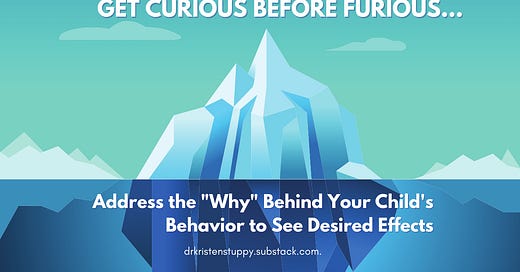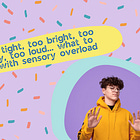Get Curious Before Furious:
Address the "Why" Behind Your Child's Behavior to See Desired Effects
Parenting can often feel like an emotional rollercoaster. One moment, everything is calm, and the next, your child is melting down over what seems like a minor issue, ignoring a simple request, or engaging in behavior you never imagined having to address. It’s natural to feel frustration or even anger in these moments — but what if we paused to ask why instead of reacting right away?
My children are now grown, but when they were young I tried to look at the why behind their behaviors before reacting. It’s hard, especially at the end of the day when we were all tired, so sometimes I failed at this. There were many little situations that grew into bigger problems because I addressed the undesired behavior before looking at the full story.
The phrase “get curious before furious” encourages us to approach undesired behaviors with curiosity and empathy. I think the first time I heard this phrase was when listening to a talk from Elaine and Diane of Impact Parents. It hit home immediately, and I recommend their books, podcast, and courses routinely. Their parenting advice is always spot on. This phrase is catchy and so very true: get curious before furious. This mindset shift not only helps us respond more effectively but also fosters stronger relationships and guides children toward better decision-making.
The Behavior Iceberg
Children's behaviors are often like icebergs: the part you see (the undesired behavior) is just the tip. Below the surface lies a wealth of underlying causes, such as unmet needs, emotions they don’t know how to express, or developmental challenges.
Examples include:
A child refusing to clean up their toys might feel overwhelmed by the task.
A teen snapping at you may be masking feelings of stress or inadequacy.
A preschooler hitting a sibling may be seeking attention they don’t know how to ask for appropriately.
By becoming curious about the hidden reasons behind behaviors, we can address the root cause rather than just the symptom. Work with your child to identify the feeling and think about the situation in new ways to feel differently.
This will lead to better outcomes and help our children learn about themselves and how to manage their emotions.
Why Kids Aren’t “Trying to Be Bad”
No child wakes up and decides, I’m going to misbehave today!
Undesired behaviors often stem from unmet needs or lagging skills. Consider these common reasons for challenging behaviors:
Emotional Dysregulation: Your child might feel lonely, sad, frustrated, or anxious but lack the words to express it. Kids and teens rarely come to you with the words, “I’m worried” or “I’m depressed.” They will more likely show their feelings rather than state them.
Developmental Stage: Children are still learning impulse control, emotional regulation, and social skills. Remember that children develop at their own pace, and these skills in particular take longer to master in those with conditions like ADHD.
Sensory Overload: Bright lights, loud noises, or even scratchy clothing can overwhelm some kids, leading to meltdowns.
Physical Needs: Hunger, exhaustion, or illness can lower a child’s ability to cope with challenges.
Seeking Connection: Misbehavior is sometimes a way of asking for attention or reassurance — even if it’s not the way we’d prefer. I often tell parents to “pay it forward” and frequently comment on and reward behaviors they appreciate. Kids will do whatever it takes to get your attention — reward them when they’re being good so they don’t have undesired behaviors just to get it.
How Curiosity Can Lead to Positive Change
When we approach a child’s behavior with curiosity, we create a safe space for them to open up and learn.
Here’s how this might play out:
You Notice an Undesired Behavior
Pause Before Reacting
Take a deep breath. This pause gives you a chance to shift from reacting emotionally to responding thoughtfully.
Exaggerate your big breaths and talk out loud about what you’re doing to calm down when you’re triggered. This models the helpful behaviors to your kids.
3. Ask Questions to Yourself
What’s going on here?
Could they be tired or hungry?
Are they feeling overwhelmed, scared, or left out?
You can involve older kids in this step.
Validate Their Feelings
Even if their behavior isn’t okay, their feelings are valid. Saying something like, “I see you’re really frustrated,” helps them feel understood and begins to de-escalate the situation. Don’t skip this step!Teach Skills and Offer Alternatives
Once you understand the why, you can guide your child toward better behaviors, but first everyone involved needs to calm their brain.
If your toddler is hitting or biting, teach them to say things like:
“I need help!”
“I’m mad!”
“I don’t want to be touched!”
“I want that!”
If your teen is overwhelmed by homework, help them first use healthy coping skills to calm down. They can’t problem solve or do homework if they’re dysregulated. Once calm, help them identify why the task is overwhelming and what they can do to make is less so, like breaking it into smaller parts or getting help to understand a difficult topic.
Follow Through with Consequences When Needed
Being curious doesn’t mean letting kids off the hook. It means addressing behaviors calmly and consistently.
The Long-Term Benefits of Curiosity
When you approach your child’s behavior with curiosity, you’re modeling emotional regulation and problem-solving skills.
Over time, this approach helps your child:
Build trust and communication with you.
Develop self-awareness and emotional regulation.
Learn healthier ways to express needs and emotions.
A Practical Example: The Case of the Thrown Backpack
Imagine this scenario:
Your 10-year-old comes home from school, throws their backpack on the floor, and snaps, “Leave me alone!”
Without first getting curious, you might yell, “Hey! Don’t talk to me that way. And I’ve told you before to put your backpack where it belongs. Get back here and put it away now!”
This response is likely going to fuel the fire that’s started and make the situation worse.
But if you pause to get curious, you might ask, “That was a rough entrance. What’s going on?”
This approach changes the situation from you yelling to you asking what is happening.
After some coaxing, your child admits they got a bad grade on a test and feel embarrassed. Now you know the behavior wasn’t about defiance but about their struggle with failure. From here, you can have a constructive conversation and offer support.
We all know this won’t magically change the situation, it will take time, patience, encouragement, and validation of their feelings, but you have a better chance of connecting with your child and learning what’s behind the behavior by getting curious before furious.
Final Thoughts
“Get curious before furious” is more than just a parenting mantra — it’s a reminder that kids need guidance, not punishment, to navigate their big emotions and challenges. By choosing curiosity over anger, we show them that we’re on their team, even when things go wrong.
And as parents, we gain the satisfaction of knowing we’re not just correcting behavior but helping our children grow into resilient, empathetic individuals.
Remember, You’ve Got This!








